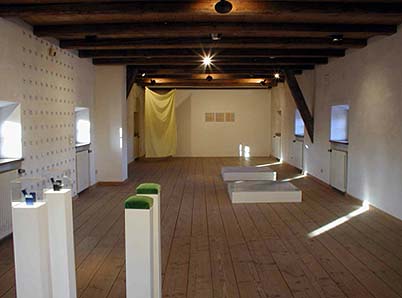|
What does ”Pro Tsubo” actually mean? catalog “Pro Tsubo” Neue Galerie Landsudt, Germany, 2004 |
||
 |
|
1)Explanation The title "Pro Tsubo" has been invented for this exhibition by combining a word in German with a word in Japanese. Tsubo is a Japanese measurement used to measure ordinary surfaces. One Tsubo is equal to two Tatamis lying side by side, which is roughly 3.3 square meters. 2)ProTsubo Exhibition Concept What does "Pro Tsubo" actually mean? Although Germany and Japan do not differ greatly in size, the living conditions in Japan feel much more crowded. An obvious reason for this is the landscape--while Japan is mostly made up of mountains, Germany has many open plains, which are more conducive to housing developments. But it is also possible that the feeling of congestion has increased in Japan. In our society new products are constantly being manufactured and the desire to purchase goods continues to grow, we are constantly flooded by commodities even though we already have enough, and the amount of information that reaches us through electronic channels, whether we want it or not, fills our everyday lives and makes them seem spatially as well as temporally constricted. In this situation, the Japanese Tsubo-perception, which has survived modernization, helps to escape the congestion of everyday life. Up until 1920 the Japanese used the concepts "shyaku" for length, "gou" for volume, "kan" for weight, and "Tsubo" for area. By 1959 these concepts were abolished and replaced with "meter," "liter," "gram," and "square meter." According to the law, "Tsubo" is no longer employed--it is a dead word--yet we continue to use this word in our language. The perception of a "Tsubo" remains customary in our everyday lives, just like the word Tatami, as most people have at least two Tatami mats at home. Whether consciously or unconsciously, the Tsubo measurement continues to be a part of people's lives. There is an interesting aspect about the word Tsubo. It not only conveys an idea of the size of a horizontal surface, but it also suggests activities that might take place in the three-dimensional space above this surface, such as standing, sitting, lying, etc. In reply to the question "What can one do on a Tsubo?" one could say "Everything." When one hears about the size of a place, one imagines at the same time a wide variety of possible activities that could be performed there. Thus the word Tsubo not only describes the size of a surface, but it also generates ideas about three-dimensional space. The Pro Tsubo exhibition features nine young artists from Japan. Despite the fact that these artists are active in the international art world outside of Japan, they also work within the context of this inner perception. Yet the works in this exhibition do not thematize spatial limitations, which the creation of art in Japan would be subject to. The works emerge solely as expressions of the individual artists. Pro Tsubo gathers together artists whose techniques and materials emphasize reserve and minimalism, and whose concepts and subjects are modest and intimate. Like the Tsubo-perception, these works are not static, but rather they create new meanings--from the surfaces in the room, from the inside out, into the depths, or across distances. "Pro" is a German word, meaning "per." The exhibition and catalog thus present nine Tsubos--nine artistic expressions, each from one Tsubo. English translation: Anthony Enns |
| - - - - TOP - - - - Copyright ERI KAWAMURA 2013 all rights reserved. |